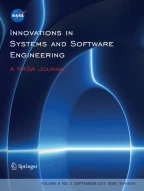Abstract
We report on the formal development of a test oracle for an electronic-voting system, detailing our approach which was based on a lightweight integration of Event-B, UML, and Java. This lightweight integration focuses on a coherent development process rather than on formal integration at the model/language level. We then briefly review alternative development approaches involving the use of JML and OCL. We conclude that the use of the OCL would offer few benefits, if any, in our formal development process.
Similar content being viewed by others
Explore related subjects
Discover the latest articles, news and stories from top researchers in related subjects.References
Abrial JR (2010) Modeling in Event-B—System and Software Engineering. Cambridge University Press, Cambridge
Abrial JR, Butler M, Hallerstede S, Hoang TS, Mehta F, Voisin L (2010) Rodin: an open toolset for modelling and reasoning in Event-B. Int J Softw Tools Technol Transf 12: 447–466
Bouquet F, Dadeau F, Groslambert J (2005) Checking JML specifications with B machines. In: Treharne H, King S, Henson MC, Schneider SA (eds) ZB, Lecture notes in computer science, vol 3455. Springer, Berlin Heidelberg, pp 434–453
Cansell D, Gibson JP, Méry D (2007) Refinement: a constructive approach to formal software design for a secure e-voting interface. Electron Notes Theor Comput Sci 183: 39–55
Chalin P, Kiniry JR, Leavens GT, Poll E (2005) Beyond assertions: advanced specification and verification with JML and ESC/Java2. In: de Boer FS, Bonsangue MM, Graf S, de Roever WP (eds) FMCO, Lecture notes in Computer Science, vol 4111. Springer, Berlin, pp 342–363
Chaum D (2004) Secret-ballot receipts: true voter-verifiable elections. In: IEEE security & privacy vol 2, No 1. IEEE, pp 38–47
Cheon Y, Leavens GT (2002) A simple and practical approach to unit testing: the JML and JUnit way. In: Proceedings of the 16th European conference on object-oriented programming, ECOOP’02. Springer-Verlag, London, UK, pp 231–255
Edmunds A, Butler M (2008) Linking Event-B and concurrent object-oriented programs. Electron Notes Theor Comput Sci 214: 159–182
Fontaine C, Galand F (2007) A survey of homomorphic encryption for nonspecialists. EURASIP J Inf Secur 2007: 1–15
Gibbs TH, Malloy BA, Power JF (2002) Automated validation of class invariants in C++ applications. In: Proceedings of the 17th IEEE international conference on automated software engineering, ASE’02. IEEE Computer Society, Washington, DC, USA, pp 205–215
Gibson JP (1993) Formal object oriented development of software systems using LOTOS. Thesis CSM-114, Stirling University
Gibson JP, Lallet E, Raffy JL (2008) Analysis of a distributed e-voting system architecture against quality of service requirements. In: The third international conference on software engineering advances (ICSEA 2008). IEEE Computer Society, pp 58–64
Gibson JP, Lallet E, Raffy JL (2009) Feature interactions in a software product line for e-voting. In: Feature Interactions in Software and Communication Systems X. IOS Press, pp 91–106
Gibson JP, Lallet E, Raffy JL (2010) Engineering a distributed e-voting system architecture: meeting critical requirements. In: Architecting Critical Systems, First International Symposium, ISARCS 2010, Prague, Czech Republic, June 23–25, 2010, Proceedings, vol 6150. Springer, pp 89–108
Hagar J, Bieman JM (1996) Using formal specifications as test oracles for system-critical software. Ada Lett XVI: 55–72
Kiniry JR, Morkan AE, Cochran D, Oostdijk M, Hubbers E (2006) Formal techniques in a remote voting system. SIGSOFT Softw Eng Notes 31(6): 1–2
Richters M, Gogolla M (2000) Validating UML models and OCL constraints. In: Evans A, Kent S, Selic B (eds) UML Lecture notes in computer science, vol 1939. Springer, Berlin, pp 265–277
Said MY, Butler MJ, Snook CF (2009) Language and tool support for class and state machine refinement in UML-B. In: Cavalcanti A, Dams D (eds) FM, Lecture notes in computer science, vol 5850. Springer, Berlin, pp 579–595
Author information
Authors and Affiliations
Corresponding author
Rights and permissions
About this article
Cite this article
Gibson, J.P., Raffy, JL. & Lallet, E. Formal object-oriented development of a voting system test oracle. Innovations Syst Softw Eng 7, 237–245 (2011). https://doi.org/10.1007/s11334-011-0167-y
Received:
Accepted:
Published:
Issue Date:
DOI: https://doi.org/10.1007/s11334-011-0167-y
